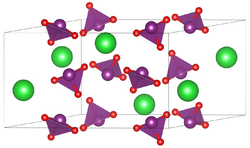Chemistry:Barium iodate
From HandWiki
 Unit cell
| |
| Identifiers | |
|---|---|
3D model (JSmol)
|
|
| ChemSpider | |
PubChem CID
|
|
| UNII | |
| |
| |
| Properties | |
| Ba(IO3)2 | |
| Molar mass | 487.13 g/mol |
| Melting point | 580 °C (1,076 °F; 853 K)(decomposes) |
Solubility product (Ksp)
|
4.01 × 10−9[1] |
| -122.5·10−6 cm3/mol | |
Except where otherwise noted, data are given for materials in their standard state (at 25 °C [77 °F], 100 kPa). | |
| Infobox references | |
Tracking categories (test):
Barium iodate is an inorganic chemical compound with the chemical formula Ba(IO3)2. It is a white, granular substance.
Derivation
Barium iodate can be derived either as a product of a reaction of iodine and barium hydroxide or by combining barium chlorate with potassium iodate.[2]
Chemical properties
The compound is stable on a temperature up to approximately 580 °C (1,076 °F). If the temperature is higher than that value, the following reaction, known as Rammelsberg's reaction, occurs:[3]
- 5 Ba(IO
3)
2 → Ba
5(IO
6)
2 + 9 O
2 + 4 I
2
References
- ↑ John Rumble (June 18, 2018) (in English). CRC Handbook of Chemistry and Physics (99th ed.). CRC Press. pp. 4–47. ISBN 978-1138561632.
- ↑ Mellor (1973). Melorova moderna neorganska hemija. Belgrade: Naučna knjiga.
- ↑ H. Stern, Kurt (2000). High temperature properties and thermal decomposition of inorganic salts. Taylor & Francis. ISBN 0849302560. https://books.google.com/books?id=2BpMo7HpXzIC&q=Ba%28IO%293&pg=PA241. Retrieved November 1, 2013.
External links
- Definition of Insoluble salts (precipitates); Solubility product
 |

